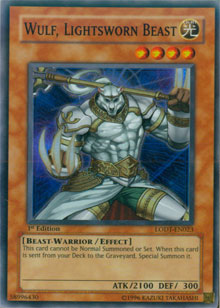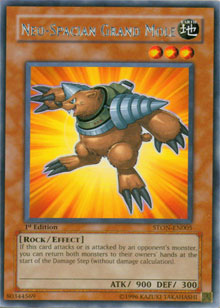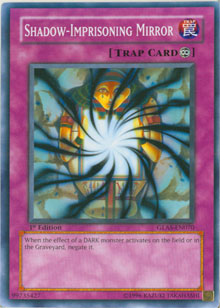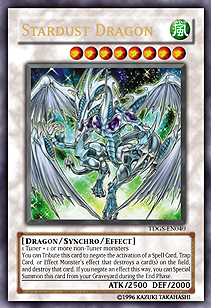Many changes can be made to a Gladiator Beast deck without injuring the deck’s synergy or consistency at all. There are several drastically different main-deck builds for Gladiator Beasts, each with more favorable matchups against different decks. With a great side deck, it’s as if you’re able to use any one of those various decks in your match. That’s what makes the Gladiator Beast side-deck strategy one of the best in the game: the deck can adapt easily to different matchups simply by removing some of the less effective cards in each and replacing them with superior cards for the situation. As long as the Gladiator toolbox remains intact, so will the deck’s consistent draws.
That leaves a lot of cards in the deck available to be rotated out and just as many available to be rotated in. In this article, I’ll be analyzing how the two most common Gladiator Beast matchups are expected to play out and which cards would be beneficial to side in and out during each match. I’ll start with the deck that is arguably the worst matchup for Gladiator Beasts.
Lightsworn
 If your Gladiator Beast deck isn’t built to beat Lightsworn, you’re most likely at a huge disadvantage in game 1. Typically, Lightsworn players swarm the field with big monsters and win very quickly. This can cause a lot of trouble for a Gladiator Beast control deck that thrives on a slower tempo. The ATK power of several Lightsworn monsters, including Wulf, Lightsworn Beast and Jain, Lightsworn Paladin, are difficult to overcome with most Gladiator Beast monsters, and copies of Necro Gardna and Honest make it difficult to successfully tag out after declaring an attack. A lock with Gladiator Beast War Chariot often means a victory for the Gladiator Beast player since every Lightsworn monster has an effect that activates during the opponent’s turn. (Note that even with Light-Imprisoning Mirror active, Lightsworn monsters still "activate" their effects during the end phase, so War Chariot can destroy them, even though the effect gets negated.) But it’s difficult to perpetuate the lock with Gladiator Beast Equeste when the deck has trouble tagging out. Fortunately, there are several side-deck options to assist.
If your Gladiator Beast deck isn’t built to beat Lightsworn, you’re most likely at a huge disadvantage in game 1. Typically, Lightsworn players swarm the field with big monsters and win very quickly. This can cause a lot of trouble for a Gladiator Beast control deck that thrives on a slower tempo. The ATK power of several Lightsworn monsters, including Wulf, Lightsworn Beast and Jain, Lightsworn Paladin, are difficult to overcome with most Gladiator Beast monsters, and copies of Necro Gardna and Honest make it difficult to successfully tag out after declaring an attack. A lock with Gladiator Beast War Chariot often means a victory for the Gladiator Beast player since every Lightsworn monster has an effect that activates during the opponent’s turn. (Note that even with Light-Imprisoning Mirror active, Lightsworn monsters still "activate" their effects during the end phase, so War Chariot can destroy them, even though the effect gets negated.) But it’s difficult to perpetuate the lock with Gladiator Beast Equeste when the deck has trouble tagging out. Fortunately, there are several side-deck options to assist.
Waboku is an amazing card in the Lightsworn matchup. It guarantees a tag-out, regardless of whether or not your opponent has Honest in his or her hand or a full field of strong monsters. More importantly, it guarantees the survival of your Gladiator Beast monster, so it can be used to Fuse into Gladiator Beast Gyzarus on the following turn. This is an incredibly strong play against Lightsworn decks, since Lightsworn often run few cards that can actually stop Gyzarus’s destruction. Furthermore, his destruction effect can help clear the opponent’s field to reduce the swarm, as Lightsworn decks quickly commit several of their cards to the field.
After maxing out on three copies of Waboku between the main deck and side deck, Defensive Tactics is also a solid side-deck choice. It functions in the same way as Waboku, but it’s often difficult for Lightsworn players to contend with five or six copies of cards that prevent them from doing battle damage. Sometimes Lightsworn players even deck themselves out because of the uncontrollable end-phase effects of the Lightsworn monsters stuck on the field.
Bottomless Trap Hole and Lightning Vortex are also solid side-deck choices for Gladiator Beast players when facing Lightsworn. Like Smashing Ground and Hammer Shot, which are becoming popular main-deck choices, these two cards help to alleviate opposing threats. Bottomless Trap Hole slows down the opponent by reducing his or her field presence, and Lightning Vortex punishes the overextension that Lightsworn decks are known for. Each of these options gives you the opportunity to summon your own monsters and attempt to attack, by eliminating the strongest of your opponent’s monsters. Bottomless Trap Hole has the added advantage of helping to prevent the summoning of Judgment Dragon and eliminating a bigger monster brought back by Lumina, Lightsworn Summoner’s effect. Gladiator Beast Hoplomus is also a strong card against Lightsworn since it defends against every level 4 or lower Lightsworn monster except for Ehren, Lightsworn Monk. This allows the game to be slowed down until it is shifted into the favor of the Gladiator Beast player.
 By now you’ve probably figured out that a highly defensive Gladiator Beast deck fares best against Lightsworn, since it’s incredibly difficult to outspeed them. Just knowing that makes the decision of which cards to side deck out much easier.
By now you’ve probably figured out that a highly defensive Gladiator Beast deck fares best against Lightsworn, since it’s incredibly difficult to outspeed them. Just knowing that makes the decision of which cards to side deck out much easier.
Cards that use up a normal summon without causing major damage to opposing threats are often ineffective against Lightsworn decks due to the speed at which they special summon monsters and present those threats. As a result, cards like Neo-Spacian Grand Mole and D.D. Warrior Lady are best placed in the side deck while playing games 2 and 3 against Lightsworn.
Thunder King Rai-Oh, which has seen an increased amount of play in Gladiator Beast decks since its release, is also worth considering side decking out. While it prevents the activation of Charge of the Light Brigade (which is often critical for a Lightsworn player) Rai-Oh uses up a normal summon just like Grand Mole, without alleviating many threats. Plus, he’s too easily destroyed. Ryko, Lightsworn Hunter, Jain, Lightsworn Paladin, Wulf, Lightsworn Beast, Celestia, Lightsworn Angel, and Honest all contribute to his destruction, and as soon as he’s destroyed, the opponent can activate all the copies of Charge of the Light Brigade that he or she was holding. Furthermore, Rai-Oh’s ability to negate a special summon (particularly of Judgment Dragon) is negated by Light-Imprisoning Mirror, a card that I would want to take the spot of Thunder King Rai-Oh after side decking.
Shrink, which is an amazing card in Gladiator Beast decks right now, is too aggressive against Lightsworn decks and too easily nullified by Honest. On the defensive, it only works against one monster, so it will rarely help against the entire swarm that Lightsworn decks present. Waboku and Defensive Tactics are superior in this matchup because of their defensive capabilities, especially when chained to the effect of Lyla, Lightsworn Sorceress. Phoenix Wing Wind Blast, which helps to reduce the opponent’s swarming capabilities, is also rather unimpressive in the Lightsworn matchup. At the cost of a discard, it only deals with a single threat. Most side-deck options are better than that. In addition, you’re likely to have very few cards that you’ll actually want to discard while playing against a deck that tries to win quickly, and that gives you few opportunities to draw cards throughout the game.
Solemn Judgment is another card to consider side decking out against Lightsworn decks. While I personally keep it in when siding against Lightsworn, I acknowledge that paying half my life has cost me several games, and many times, Solemn Judgment was destroyed by Lyla anyway. But I also acknowledge that Solemn Judgment has won me several games against Lightsworn by negating the summoning of Judgment Dragon or even the summoning of Lumina to prevent the opponent from building field presence. Solemn can also help to protect Light-Imprisoning Mirror when it’s locking down the opponent’s potential plays and leading to an easy victory. Solemn doesn’t help much after the opponent has already built up a large field of strong monsters, but it’s a solid preventative measure. It shouldn’t be a first choice to side out while running Gladiator Beasts, but if there are few other cards you want to remove, you may want to remove Solemn Judgment against Lightsworn decks because of how fast they can deal damage.
Suggestion Summary:
In: Light-Imprisoning Mirror, Bottomless Trap Hole, Lightning Vortex, Waboku, Defensive Tactics
Out: Neo-Spacian Grand Mole, Thunder King Rai-Oh, Shrink, Phoenix Wing Wind Blast, and, if necessary, Solemn Judgment
Teleport Dark Armed Dragon
If your main deck isn’t already prepared for it, side decking against TeleDAD is extremely important. Since TeleDAD is generally seen as the dominant deck in current metagames, most main decks already include tech to give them an edge in the TeleDAD matchup. As a result, side decking often isn’t as extensive. But there are still several Gladiator Beast cards that are amazing against TeleDAD, and a few cards that aren’t always as effective. That means that side-deck options should always be considered, no matter how prepared you are in game 1.
TeleDAD is mostly a combo deck. It uses Destiny Hero - Malicious and Emergency Teleport to create Synchro monsters that win the duel. But the deck is not without flaw. With three copies of each of its key cards, the deck tries to win fast, but easily runs out of threats when it uses up all copies of Malicious and/or Krebons. After that, the only large threat is usually Dark Armed Dragon. So by aiming to quickly disassemble or prevent the opponent’s combo strategy, you can devise the perfect side-deck plan.
 is an obvious side-deck choice. It negates the effect of Destiny Hero - Malicious and neutralizes Dark Armed Dragon, effectively eliminating all combo potential. Royal Oppression serves a similar purpose, negating the Synchro summons and the summoning of Dark Armed Dragon. That’s all of the major threats. I’ve never liked Royal Oppression in the Gladiator Beast side deck because of the large amount of special summoning that Gladiator Beasts themselves thrive off of, but it’s certainly a card worth mentioning for its ability to nearly shut down one of the most commonly played decks in the current metagame.
is an obvious side-deck choice. It negates the effect of Destiny Hero - Malicious and neutralizes Dark Armed Dragon, effectively eliminating all combo potential. Royal Oppression serves a similar purpose, negating the Synchro summons and the summoning of Dark Armed Dragon. That’s all of the major threats. I’ve never liked Royal Oppression in the Gladiator Beast side deck because of the large amount of special summoning that Gladiator Beasts themselves thrive off of, but it’s certainly a card worth mentioning for its ability to nearly shut down one of the most commonly played decks in the current metagame.
Of course, you can’t always depend on drawing and activating continuous traps cards before the opponent can start Synchro summoning monsters. When the opponent goes first, for instance, he or she has the opportunity to start Synchro summoning monsters before you even get to set a trap. Furthermore, continuous traps that all serve the same purpose or similar purposes, like multiple copies of Shadow-Imprisoning Mirror and/or Royal Oppression, create dead draws when drawn together. That’s why sometimes it’s better to react to the opponent’s threats, rather than trying to prevent them.
Neo-Spacian Grand Mole is one of the few cards capable of getting both Stardust Dragon and Thought Ruler Archfiend off of the field, plus it’s reusable. Mirror Wall is also worth considering against TeleDAD, because it can assist a monster with decent ATK power to destroy both Stardust Dragon and Thought Ruler Archfiend. That kind of versatility is hard to find. Compulsory Evacuation Device and Phoenix Wing Wind Blast are good cards against TeleDAD because they provide simple solutions to every Synchro monster except Thought Ruler Archfiend. They can also provide temporary relief from Dark Armed Dragon by giving Dark Armed back to the opponent while he or she doesn’t have exactly three Darks in the graveyard.
One the strongest cards against TeleDAD is Thunder King Rai-Oh. He’s most effective when going first, since he prevents the opponent from using the search effect of Elemental Hero Stratos or activating Reinforcement of the Army, but he’s a strong card throughout the entire game. His ability to negate any special summon makes him a Royal Oppression that can’t backfire, and his 1900 ATK makes him a dead draw less frequently. The lack of simple monster removal in TeleDAD decks is a serious flaw in the strategy, and makes it extremely difficult for TeleDAD players to get Thunder King Rai-Oh off of the field without using Phoenix Wing Wind Blast or trying to special summon a big monster (and losing that monster to the Thunder King). Nothing helps to control the opponent’s plays more than Thunder King Rai-Oh, which makes him a perfect fit for the Gladiator Beast deck.
Some of the cards that I just suggested to give you an edge while playing against TeleDAD are probably already in your main deck. That means you’ll likely only want to fit a few more of those cards in, and you’ll only need to take a few cards out when side decking.
Against TeleDAD, Gladiator Beast Gyzarus just isn’t as effective as he is against other decks thanks to Stardust Dragon’s ability to negate his effect and destroy him. As a result, neither is the Elemental Hero Prisma engine, which mainly focuses on summoning Gyzarus. The Prisma engine’s weakness to Stardust Dragon could be offset by playing several trap cards that can remove Stardust from the field, so if you insist on keeping Prisma in your deck, it would help to run several traps to get rid of Stardust Dragon (like Compulsory Evacuation Device), even if they aren’t solutions to Thought Ruler Archfiend. Since Gyzarus himself is a strong solution to Thought Ruler, it’s unlikely that your opponent will want to summon him anyway, knowing Gyzarus can destroy him and take control of the match.
 Unless Stardust Dragon is a top concern for your Gladiator Beast deck, Dimensional Prison (although capable of removing some powerful monsters from play) is often ineffective against TeleDAD. It’s not chainable, so it fails to help against the threat that many Gladiator Beast players perceive as the greatest danger: Dark Armed Dragon. It also targets, so Thought Ruler Archfiend can negate it. You may also want to consider side decking out similar traps that cannot be chained to destruction effects.
Unless Stardust Dragon is a top concern for your Gladiator Beast deck, Dimensional Prison (although capable of removing some powerful monsters from play) is often ineffective against TeleDAD. It’s not chainable, so it fails to help against the threat that many Gladiator Beast players perceive as the greatest danger: Dark Armed Dragon. It also targets, so Thought Ruler Archfiend can negate it. You may also want to consider side decking out similar traps that cannot be chained to destruction effects.
Bottomless Trap Hole is also rather ineffective against TeleDAD because of its inability to get Stardust Dragon off of the field for good. Unlike Smashing Ground, it’s unlikely that you will successfully be able to make a follow-up play involving a tag-in of Gladiator Beast Retiari to remove Stardust in the same turn that Bottomless is activated. Bottomless Trap Hole is able to remove Dark Armed Dragon from play, which is always a good thing, but it can’t provide a solution to Stardust when it’s summoned, nor any other Synchro monster after it has already hit the field. It can’t be chained to an opponent’s Heavy Storm, Mystical Space Typhoon, or Giant Trunade, so if the opponent activates one of those cards with the hopes of winning that turn, Bottomless Trap Hole won’t help you.
That makes several other trap choices better in the TeleDAD matchup. Trap Dustshoot (which is generally a great card against a combo deck) may also be worth side decking out, especially when you’ll be going second. TeleDAD players empty their hands pretty quickly to fill up their fields, and once that happens Trap Dustshoot becomes useless. In addition, Dark Armed Dragon is one of the few monster cards that TeleDAD players actually want to draw and keep in their hand.
With so many great cards in the side deck against TeleDAD but so few that you probably want to remove, it may be worth it to sacrifice a little consistency in order to play some game-breaking tech in games 2 and 3. Just make sure you keep the Gladiator Beast toolbox intact so that your options don’t decrease in games 2 and 3 when you tag in Gladiators. If you main three copies of Gladiator Beast Laquari, for instance, you may consider side decking one out. It’s not because Laquari is worse than usual in the TeleDAD matchup. He’s still the strongest level 4 Gladiator Beast monster that can tag out and work with Gladiator Beast War Chariot and Gladiator Beast’s Respite. But removing a Gladiator Beast monster that you only run one of would damage the versatility of your toolbox, and drawing that critical copy of Shadow-Imprisoning Mirror will often mean more than drawing an extra copy of Laquari. A Gladiator Beast that you run three of (maybe even two of) can be safely sided out without damaging the synergy between the Gladiator Beast monsters. Similarly, Gladiator Beast’s Respite is a great card for smoothing over bad draws, but it can be removed with little consequence, and it would be logical to remove alongside the Gladiator Beast monsters that it would send back to the deck.
Suggestion Summary:
In: Shadow-Imprisoning Mirror, Neo-Spacian Grand Mole, Thunder King Rai-Oh, Compulsory Evacuation Device
Out: Dimensional Prison, Bottomless Trap Hole, Trap Dustshoot, and, if necessary, extra copies of Gladiator Beast cards.
That covers some side-decking strategies against two of the most popular decks in the current metagame. In my next article, I’ll be continuing my discussion with the Gladiator Beast side-deck strategy against other competitive, but less commonly played decks.
—Michael Kohanim